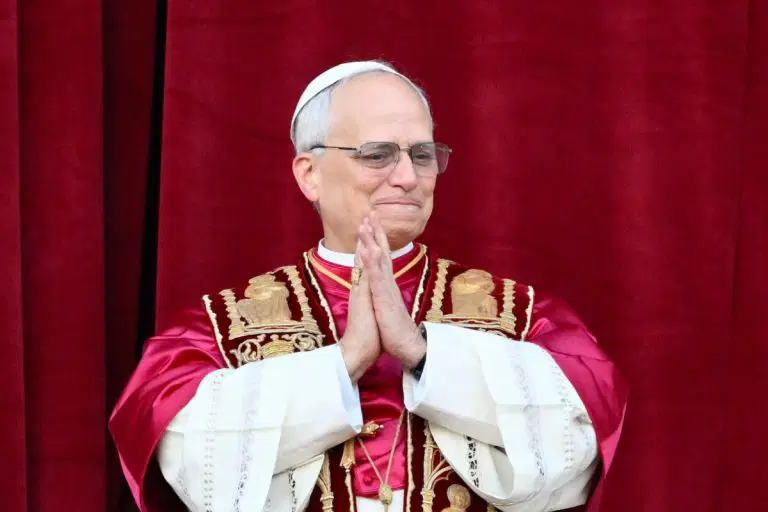Headline
Delayed Justice: 3 States In US Remove All Time Limits On Child S3x Abuse Lawsuits

Ann Allen loved going to church and the after-school social group led by a dynamic priest back in the 1960s.
The giggling fun with friends always ended with a game of hide and seek. Each week, the Rev. Lawrence Sabatino chose one girl to hide with him. Allen said when it was her turn, she was sxually assaulted, at age 7, in the recesses of St. Peter’s Catholic Church.
“I don’t remember how I got out of that cellar and I don’t think I ever will. But I remember it like it’s yesterday. I remember the smells. The sounds. I remember what he said, and what he did,” she said.
Allen, 64, is one of more than two dozen people who have sued the Roman Catholic Diocese of Portland, Maine, over the past year, seeking delayed justice since lawmakers allowed lawsuits for abuse that happened long ago and can’t be pursued in criminal courts either because of time limits or evidence diminishing over time.
More survivors are pursuing cases as states increasingly consider repealing time limits for child sex crime lawsuits. Vermont was the first state to remove the limits in 2019, followed by Maine in 2021 and Maryland this year.
Michigan, Rhode Island and Massachusetts are poised to take action before their legislative sessions end.
“The momentum is irreversible,” said Marci Hamilton, CEO of CHILD USA, a think tank aiming to prevent child abuse and neglect.
In April, Maryland lifted time limits on child sexual abuse lawsuits against institutions less than a week after the attorney general detailed decades of abuse of more than 600 children by over 150 priests associated with the Archdiocese of Baltimore.
Other states, meanwhile, have briefly removed the statute of limitations on lawsuits for childhood abuse. More than 10,000 lawsuits were filed when New York set aside time limits for two years.
Across the country, those lawsuits have targeted churches, summer camps, scout groups and other institutions accused of enabling pedophiles or turning a blind eye to wrongdoing.
READ ALSO: Trump Indicted In Classified Documents Probe
More states eliminating the limits would help achieve justice and prevention, according to advocates who say survivors tend to keep the trauma to themselves, backed by new research suggesting survivors typically come forward in their 50s.
“More and more people come forward as they realize that they’re not alone,” said Michael Bigos, one of Allen’s attorneys, whose law firm has brought 25 lawsuits since last June and is evaluating more than 100 additional potential cases, including about 65 targeting the Portland diocese.
In his law offices, Allen looked at a photo of herself at her first communion at St. Peter’s, which serves what was once Portland’s Little Italy neighborhood and hosts a popular street party each summer.
The photo was taken after the assault. Her joy and exuberance are gone. “When I look at it, I see a pretty damaged child,” she said.
Sabatino quickly became part of the fabric of St. Peter’s when he arrived in 1958 after leaving another church where parents reported to police that he had sexually abused their 6-year-old daughter. The priest was warned by the Diocese of Portland not to engage with children or play games, but was soon doing both.
Parishioners, including Ann Allen’s family, invited him into their homes. He visited her family’s beach house.
READ ALSO: JUST IN: Ex-US Presidential Candidate, Renowned Religious Broadcaster Dies At 93
Allen thought she was lucky when she was selected to hide with him. But the abuse became a dark secret she carried for decades.
She never considered telling her parents. Allen said she didn’t think anyone would believe her.
“School principal in California, Allen was protective of children, especially those who reported abuse. She would try to help them and say right things — things she wished had been done for her. Then, she went home to “curl up in a ball,” she said.
But her secret came bubbling back when she returned to Maine and had to confront her past, she said.
Robert Dupuis tells a similar story.
He was 12 years old in 1961 when he was abused by the Rev. John Curran in Old Town, a riverside city in Maine. Decades later, he sought help from Alcoholic’s Anonymous when his marriage was in jeopardy. He acknowledged the abuse in group therapy, at around age 55, and the revelation changed his life.
“It healed me and it freed me from holding back,” the 74-year-old said.
His marriage and friendships have improved, he said. Now, he encourages others who have been abused to come forward.
Most of Maine’s newly filed civil lawsuits target the Diocese of Portland, accusing leaders of ignoring accusations against priests like Sabatino and Curran, or simply moving them to new parishes, allowing the abuse to continue.
Diocese officials concluded that allegations against Sabatino and Curran were credible. Both have long since died.
Maine removed its time limits in 2000 to sue over childhood sexual abuse, but not retroactively, leaving survivors without recourse for older cases. Changes in 2021 allowed previously expired civil claims. The Legislature also is considering easing the statute of limitations on criminal charges for sexual assaults of children.
The Portland diocese contends survivors had ample time to sue and it’s unconstitutional to open the door to new litigation, which could lead to requests for damages of “tens of millions of dollars.”
A judge rejected the arguments. The diocese has appealed to the state supreme court. An attorney and a spokesperson for the diocese both declined comment.
READ ALSO: Trump Risks 10 Yrs In Prison Over Classified Documents Case Indictment
For Patricia Butkowski, it was 1958 when her family alerted police that she said Sabatino assaulted her at a parish in Lewiston. After the diocese transferred him to Portland, Allen and others became victims.
“I’m now at 70 feeling emotions and allowing myself to feel emotions that I never knew I had. Anger is at the top of it. I’m like a volcano spewing and there’s just so many emotions, and anger at the church,” she said.
Butkowski, who now lives in Oklahoma City, wants the church to apologize and acknowledge the wrongs done to her and others so she can “hopefully regain some sort of faith before I die,” she said.
“What was done to me by the priest damaged my soul,” she said. “I don’t have a soul anymore. It’s broken.”
Headline
Coup: Guinea-Bissau Junta Releases Six Held Opposition Politicians

Guinea-Bissau’s ruling junta on Tuesday released six members of the political opposition who had been detained since a coup last month.
The six freed opposition members are said to be close associates of Domingos Simoes Pereira, head of the PAIGC party that led the country to independence in 1974.
Pereira has been in custody since the coup.
In a statement by the High Military Command, the junta’s governing body, the releases are described as a sign of good faith and a step towards the return to constitutional normality and respect for international rights.
READ ALSO:Why West African Troops Overturned Benin’s Coup But Watched Others Pass
The army seized power on 26 November after ousting outgoing President Umaro Sissoco Embalo in the wake of a presidential vote.
After taking over, the military suspended the electoral process and announced it would take control of the West African country for a period of one year.
Recall that another opposition candidate, Fernando Dias, took refuge in Nigeria’s embassy, which granted him asylum, while Embalo fled the country after being briefly detained by the military at the time of the coup.
Meanwhile, Senegal’s Foreign Minister, Cheikh Niang, led a delegation to Guinea-Bissau, where he met with detained opponents and requested their release.
Headline
7 Territories Still Under Colonial Rule

Even though most nations became independent in the last century, some territories are still ruled by other nations.
Contents
1. Western Sahara
2. Guam
3. American Samoa
4. United States Virgin Islands
5. Falkland Islands / Malvinas
6. Gibraltar
7. Bermuda
Many of them remain on the United Nations list of non-self-governing territories, meaning they have not completed the process of decolonization. These places usually depend on bigger countries for laws, passports, defence, or political control.
In this article, Nigerian Tribune highlights 7 territories still under colonial rule:
READ ALSO:Nigeria Ranks World’s 102nd Happiest Nation, US, Germany Not Among 20 Top Counties
1. Western Sahara
Western Sahara remains one of the world’s biggest unresolved colonial issues. Morocco controls most of the territory, but the Polisario Front wants independence for the Sahrawi people. The UN is still trying to help both sides agree on a peaceful solution.
2. Guam
Guam is an important US territory in the Pacific, used heavily for American military operations. The US oversees its defence and foreign relations.
People living there are US citizens, but they cannot vote in presidential elections and do not have full representation in Congress.
READ ALSO:FULL LIST: US To Review Green Cards From 19 ‘Countries Of Concern’ After Washington Shooting
3. American Samoa
American Samoa has more local control than Guam, but the United States still decides immigration, defence, and foreign affairs.
Residents are considered US nationals and must apply if they want full citizenship.
4. United States Virgin Islands
The US Virgin Islands have their own legislature, but the United States makes major constitutional and political decisions. The territory depends heavily on US federal support.
5. Falkland Islands / Malvinas
The Falkland Islands remain controlled by the United Kingdom (UK), but Argentina has long disputed this claim, having been in control of the Islands for a few years before 1833.
The people living there voted strongly to stay British, yet the sovereignty dispute continues to appear in the UN.
READ ALSO:Six Countries With Highest Number Of Billionaires In 2025
6. Gibraltar
Gibraltar sits at the Southern tip of Spain. The United Kingdom controls it, but Spain insists the territory belongs to them.
Gibraltarians have repeatedly voted in favour of remaining British, but the dispute is still discussed within the UN Decolonisation Committee.
7. Bermuda
Bermuda is a British Overseas Territory situated in the North Atlantic Ocean. Although it manages most of its own internal affairs and enjoys a strong economy with modern facilities, the United Kingdom still handles its defence and represents it in global matters.
Headline
Russia-Ukraine War: Pope Leo Calls For Global Christmas Truce

Pope Leo XIV on Tuesday renewed his call for a global truce on Christmas Day, saying he felt “great sadness” after Russia “apparently rejected a request” for a pause in fighting.
Speaking to reporters at his residence in Castel Gandolfo near Rome, the Pope urged all sides involved in conflict to observe at least one day of peace.
“I am renewing my request to all people of goodwill to respect a day of peace — at least on the feast of the birth of our Saviour,” Leo said.
Recall that Russia invaded Ukraine in February 2022 and has repeatedly turned down calls for a ceasefire, arguing that any pause would give Ukraine a military advantage.
READ ALSO:Russian Strikes Kill Five In Ukraine, Cause Power Outages
“Among the things that cause me great sadness is the fact that Russia has apparently rejected a request for a truce,” the pope said.
Referring to conflicts worldwide, Leo added, “I hope they will listen and there will be 24 hours of peace in the whole world.”
The appeal came as fighting continued in eastern Ukraine. On Tuesday, Ukrainian forces withdrew from a town after heavy battles with Russian troops. Russian strikes killed three civilians and left thousands without power during winter temperatures.
READ ALSO:Trump Blasts Ukraine For ‘Zero Gratitude’ Amid Talks To Halt War
There was no indication of progress toward ending the war after separate meetings last weekend in Miami between the United States officials and negotiators from Russia and Ukraine. The conflict is nearing four years with no settlement in sight.
Earlier this month, Pope Leo met Ukrainian President Volodymyr Zelensky. When asked whether he would accept Zelensky’s invitation to visit Ukraine, the pope said, “I hope so,” while noting that it was not possible to say when such a visit could happen.
Leo also warned that efforts to secure peace without European diplomatic involvement were “unrealistic”, expressing optimism that President Donald Trump’s proposed peace plan could bring a “huge change” to the transatlantic alliance.

 News3 days ago
News3 days agoPHOTOS: New Era In Furupagha-Ebijaw As Okpururu 1 Receives Staff Of Office

 News2 days ago
News2 days agoUBTH CMD Marks 120 Days In Office, Expresses Commitment To Providing Conducive Working Environment

 News3 days ago
News3 days agoFG Declares Public Holidays For Christmas, New Year Celebrations

 News3 days ago
News3 days agoOPINION: Gumi And His Terrorists

 News3 days ago
News3 days agoFIRS Confirms NIN As Tax ID

 News3 days ago
News3 days agoOPINION: Christmas And A Motherless Child

 News3 days ago
News3 days agoOPINION: My Man Of The Season

 Metro2 days ago
Metro2 days agoFintiri Pardons Man Sentenced To Death For ‘Killing Herdsman In Self-defence’, Others

 News3 days ago
News3 days agoKWAM 1 Withdraws From Awujale Race, Ends Court Challenge

 Metro2 days ago
Metro2 days agoPetrol Tanker Crashes Into Akpabio’s Convoy, Kills Police Dispatch Rider






























